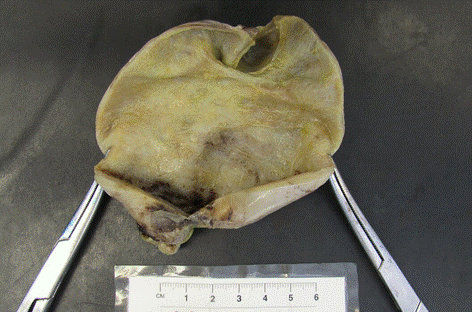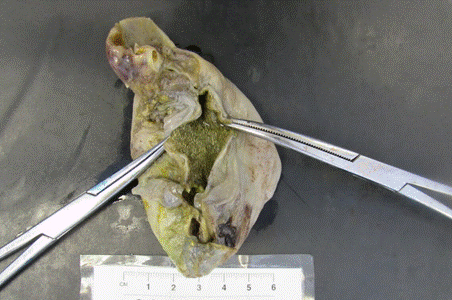Introduction
The rectum is the final part of large intestine. The adult human rectum is about 12 cm (4.7 in) long, and begins at the rectosigmoid junction at the level of the third sacral vertebra or the sacral promontory. Its caliber is similar to that of the sigmoid colon at its commencement, but it is dilated near its termination, forming the rectal ampulla. It terminates at the level of the anorectal ring (the level of the puborectalis sling) or the dentate line. It terminated at the anal canal which is about 4 cm (1.6 in) long, before the gastrointestinal tract terminates at the anal verge. The blood supply of the rectum for proximal two thirds is by the superior rectal artery and the lower third is supplied by the middle and inferior rectal arteries [1].
Trans anal intestinal evisceration is rare and dramatic occurrence, linked most frequently to rectal prolapse rupture or, very rarely, to traumatic pathology. This is the situation in which the small bowel herniates through a rupture in the rectal wall and eviscerates through the anal canal. Moreover, less than 70 similar cases have been described in the literature since its first description by Brodie in 1827 [2]. In Oman, no previous similar case reported in literature.
Diagnosis is usually clinical, as the patient usually presented with evisceration of bowel through the anus, anal pain, with or without evidence of intestinal obstruction or peritonitis.
With more frequent use of computed tomography in the evaluation of patients with abdominal pain, the condition can be diagnosed more reliably.
In this case report, we are presenting young adult male, who came with trans-anal evisceration of small bowel complicated with features of subacute intestinal obstruction.
Case presentation
A 39- years-old men presented to the emergency casualty with abdominal pain, vomiting and loose motion for three days duration. It is associated with prolapsed small bowel loop through the anus with no bleeding per rectum. The pain is colicky in nature and radiated to all over the abdomen with association to non-bilious vomiting and loose motion and central abdominal distention. No history of chronic rectal prolapse and he deny any history of trauma. On examination, he looks ill, dehydrated, tachycardic and low blood pressure. On abdominal examination, there is tenderness over the left iliac fossa and center of the abdomen, bowel sound audible and 25 cm of small bowel protruded through the rectum with edematous wall but looks viable, no bleeding per rectum and minimal digital rectal examination showed decrease rectal tone. (Figure 1)

Figure 1. minimal digital rectal examination showed decrease rectal tone
CT abdomen showed, dilated small bowel loops, rectum is pushed lateral and inferior with multiple bowel loops, terminal ileum and cecum are not in the right iliac fossa which is likely rotated and descended down in the rectum, finding is likely internal hernia with sign of complete obstruction. Laparotory investigations within normal range including RFT, LFT, CBC, CRP and INR. After resuscitation, analgesia and iv antibiotics, the eviscerated bowel was washed with saline and covered with saline socked mopes. Then, he was taken to theater, in a lithotomy position, reduction of bowel content was done successfully, in addition, a midline vertical laparotomy was done, resection and end-to-end anastomosis for unhealthy small bowel segment and closure of the rectal injury in two layers, in addition to that, diversion colostomy was applied. (Figure 2)

Figure 2. Application of diversion colostomy
Large size drain kept inside and mass cloture of the abdomen was done. The patient recovered well from anesthesia and uneventful post operative period.
Discussion
In the literature, such pathology for the patient in our case was reported very rarely as less than 70 similar cases have been described since its first description by Brodie in 1827 [2]. Furthermore, our case is first case to be reported in Oman with same pathology.
The predisposing factors for trans-anal evisceration of bowel can be due to a rectal prolapse with a long evolution because such a prolapse induces ischemia in the neck of the hernia pouch and in the anterior rectal wall [3]. Other factors related to this pathology are the presence of abnormally-wide rectovesical/rectovaginal pouches, the existence of an underlying colorectal pathology (diverticulosis, colitis, ulceration, neoplasia, etc.), iatrogenic causes, and closed abdominal trauma [4]. In our case the exact cause is unknown as the patient did not gave any history of rectal prolapse or trauma.
The diagnosis of evisceration of small bowel through the anal canal occasionally require high index of suspicion as it mimic rectal prolapse, specially if a very small segment of bowel is eviscerated.
The management of trans-anal evisceration of bowel depend on the viability of the herniated bowel and present of peritonitis, associated with co-morbidities and general condition of the patient [5].
Reduction of eviscerated bowel into peritoneal cavity should be done at operative theater under anesthesia and under full aspect condition. Moreover, resection of gangrenous bowel should be done with primary anastomosis and repair of the rectal defect, which same was done in our case.
In reported series, when the perforation of the rectum was left untreated or only reduced, mortality was 100%. When the tear was only sutured, the mortality decreased to 46%, whereas when suturing was accompanied by a colostomy, the mortality declined to 23%. Hartmann’s procedure has been reported in only three cases (including the above-mentioned), and those involved no mortalities [6].
Conclusion
Trans-anal evisceration is a rare surgical emergency carrying high rate of mortality and morbidity if not deal with it in urgent and prober way of treatment modality.
The predisposing factors for trans-anal evisceration of bowel can be due to a rectal prolapse with a long evolution, the presence of abnormally-wide rectovesical/rectovaginal pouches, the existence of an underlying colorectal pathology (diverticulosis, colitis, ulceration, neoplasia, etc.), iatrogenic causes, and closed abdominal trauma.
The management of trans-anal evisceration of bowel depend on the viability of the herniated bowel and present of peritonitis, associated with co-morbidities and general condition of the patient. However, in all patients, the initial resuscitation, analgesia, iv antibiotics and prompts surgical intervention are necessary steps.
Conflict of interest
None
References
- Wolff BG, Fleshman JW, Beck DE, Pemberton JH, Wexner SD, et al. (2007), The ASCRS textbook of colon and rectal surgery, New York: Springer.
- Morris AM, Setty SP, Standage BA (2003) Acute transanal evisceration of the small bowel: report of a case and review of the literature. Dis Colon Rectum 46:1280-1283. [Crossref]
- Furuya Y, Yasuhara H, Naka S, Yamazaki K, Yanagie H, et al. (2008) Intestinal evisceration through the anus caused by fragile rectal wall. Int J Colorectal Dis 23: 721-722. [Crossref]
- Ellul JP, Mannion S, Khoury GA (1995) Spontaneous rupture of the rectum with evisceration of the small intestine through the anus. Eur J Surg 161: 925-927. [Crossref]
- Joon Joeng HA (2000) Rupture of recto sigmoid colon with evisceration of the small bowel through anus. YMJ 41: 289-292. [Crossref]
- Al-Abkari M (2000) Spontaneous rupture of the rectum with evisceration of omentum through the anus: a case report and review of the literature. Ann Saudi Med 20: 246-247.


